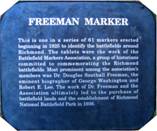 |
National Park Service
Plate
This is one in a series of 61
markers erected beginning in 1925 to
identify
the battlefields around Richmond. The tablets were the work
of the Battlefield Markers Association, a
group of historians committed
to commemorating
the Richmond battlefields. Most prominent among the
association's members was Dr. Douglas Southall
Freeman, the eminent
biographer of George
Washington and Robert E. Lee. The work of Dr.
Freeman and the Association ultimately led to
the purchase of battlefield
lands and the
establishment of Richmond National Battlefield Park
in 1936. |
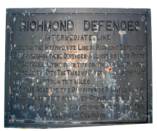 |
#1 Richmond Defences Intermediate
Line
Here ran the
intermediate line of Richmond defences. Built in 1862-64,
these defences included 25 inner forts and
batteries, beyond which
this continuous
earthwork encircled the city. The third or outer line
was distant from the capitol 4 to 7 miles. Out
this road the two divisions
of D.H. Hill and
of James Longstreet followed Gen. R.E. Lee on June
26, 1862, for the opening battle of the Seven
Days' Campaign. [Marker
not numbered] |
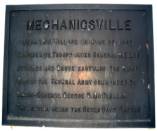 |
#2 Mechanicsville
Near this village on
June 26, 1862, Confederate troops under General
R.E. Lee attacked and drove eastward the right
wing of the Federal
army commanded by
Major-General George B. McClellan. This action began
the Seven Days' Battle. |
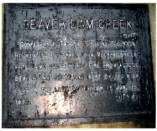 |
#3 Beaver Dam Creek
Confederate troops pursuing
Federals retreating eastward from Mechanicsville
here came under heavy fire from across Beaver
Dam Creek and were halted
with loss in the
late afternoon of June 26, 1862. |
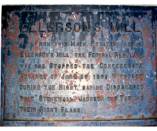 |
#4 Ellerson's Mill
From this main position above
Ellerson's Mill, the Federal regulars
who had
stopped the Confederate advance of June 26, 1862 withdrew
during the night, having discovered that
"Stonewall" Jackson was turning
their right
flank. |
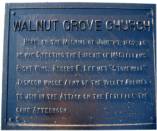 |
#5 Walnut Grove Church
Here, on the morning of June 27,
1862, as he was directing the pursuit
of
McClellan's right wing, Robert E. Lee met "Stonewall" Jackson whose
Army of the Valley arrived to join in the
attack on the Federals the
same afternoon. |
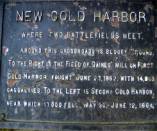 |
#6 New Cold Harbor Where Two
Battlefields
Meet
Around this
crossroads is bloody ground. To the right is the field
of Gaines' Mill or First Cold Harbor, fought
June 27, 1862, with 14,800
casualties. To the
left is Second Cold Harbor, near which 17,00 fell,
May 30 - June 12, 1864. |
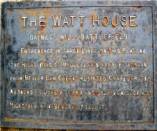 |
#7 The Watt House Gaines' Mill
Battlefield
Entrenched in three lines
on this plateau, the right wing of McClellan's
army, withdrawn from Beaver Dam Creek,
resisted Confederate attacks
on June 27, 1862
until driven back at nightfall by a general assault. |
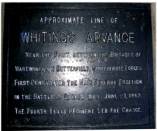 |
#8 Approximate Line of
Whiting's
Advance
Near this
point, between the brigades of Martindale and Butterfield,
Confederate forces first penetrated the main
Federal position in the
Battle of Gaines'
Mill, June 27, 1862. The Fourth Texas Regiment led
the charge. |
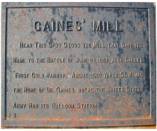 |
#9 Gaines' Mill
Near this spot stood the mill that
gave its name to the battle of
June 27, 1862
also called “First Cold Harbor”. About 1500 yards SSW
was the home of Dr. Gaines, where the United
States Army had its balloon
station. |
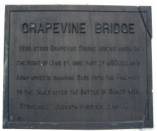 |
#10 Grapevine Bridge
Here stood Grapevine Bridge
across which, on the night of June 27,
1862,
part of McClellan's Army moved in changing base from the Pamunkey
to the James after the Battle of Gaines' Mill.
"Stonewall" Jackson
pursued, June 29. |
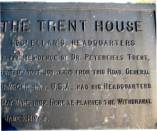 |
#11 The Trent House McClellan's
Headquarters
In
the residence of Dr. Peterfield Trent, situated about 500 yards
from this road, General G.B. McClellan,
U.S.A., had his headquarters
in May-June,
1862. Here he planned the withdrawal to James River. |
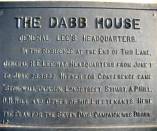 |
#12 The Dabb House General Lee's
Headquarters
In
the residence at the end of this lane, General R.E. Lee had
headquarters
from June 1 to June 26, 1862.
Hither for conference came “Stonewall”
Jackson, Longstreet, Stuart, A.P. Hill, D.H.
Hill and other of his
lieutenants. Here the
plan for the Seven Days’ Campaign was drawn. |
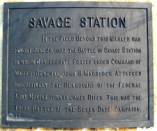 |
#13 Savage Station
In the field beyond this marker
was fought June 29, 1862, the battle
of Savage
Station in which Confederate forces under command of Major-General
John B. Magruder attacked indecisively the
rearguard of the Federal
Army moving toward
James River. This was the Third Battle of the Seven
Days’ Campaign. [Moved from Old Williamsburg
Road South of here] |
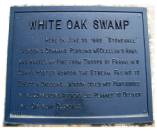 |
#14 White Oak Swamp
Here on June 30, 1862,
“Stonewall” Jackson's command, pursuing McCellan's
Army, was halted by fire from troops of
Franklin's Corps posted across
the stream.
Failing to effect a crossing, Jackson could not participate
in the converging attacks Lee planned to
deliver that day near Glendale. |
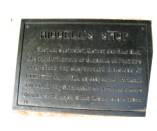 |
#15 Riddell's Shop
West and Southwest, distant
one-half mile lies the Battlefield of
Glendale
or Frazier's Farm, where the Confederate divisions of Longstreet
and A.P. Hill on June 30, 1862, attacked and
forced the withdrawal
of Federal troops
covering McClellan's march toward James River. |
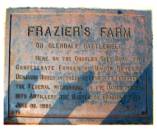 |
#16 Frazier's Farm or Glendale
Battlefield
Here, on the Charles City
Road, the Confederate forces of Major General
Benjamin Huger in their attempt to intercept
the Federal withdrawal
to the James opened
with artillery the Battle of Frazier's Farm, June
30, 1862. |
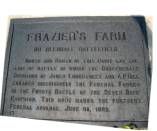 |
#17 Frazier's Farm or Glendale
Battlefield
North and South of this
point lay the line of battle in which the
Confederate commands of James Longstreet and
A.P. Hill engaged indecisively
the Federal
forces in the Fourth Battle of the Seven Days’ Campaign.
This spot marks the furthest Federal advance,
June 30, 1862. |
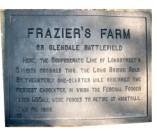 |
#18 Frazier's Farm or Glendale
Battlefield
Here, the Confederate line
of Longstreet's Division crossed this,
the
Long Bridge Road. Southeasterly one-quarter mile occurred the
fiercest encounter, in which the Federal
forces under McCall were
forced to retire at
nightfall June 30, 1862. |
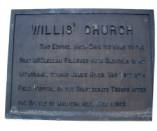 |
#19 Willis' Church
This edifice, which gave its
name to the road McClellan followed from
Glendale in his withdrawal toward James River,
was used as a field
hospital by the
Confederate troops after the Battle of Malvern Hill.
July 1, 1862. |
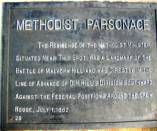 |
#20 Methodist Parsonage
The residence of the
Methodist minister, situated near this spot,
was a landmark of the Battle of Malvern Hill
and was directly in the
line of advance of
D.H. Hill's division southward against the Federal
positions around the Crew house. July 1,
1862. |
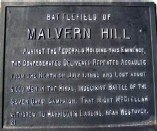 |
#21 Battlefield of Malvern Hill
Against the Federals holding this
eminence, the Confederates delivered
repeated
assaults from the North on July 1, 1862 and lost about 5,000
men in the final, indecisive Battle of the
Seven Days’ Campaign. That
night McClellan
withdrew to Harrison's Landing, near Westover. |
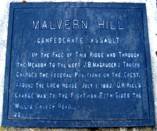 |
#22 Malvern Hill Confederate
Assault
Up the face of this ridge and
through the meadow to the left J.B.
Magruder's
troops charged the Federal positions on the crest, around
the Crew House, July 1, 1862. D.H. Hill's
charge was to the right,
on both sides of the
Willis Church Road. |
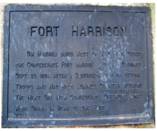 |
#23 Fort Harrison
Six hundred yards West of this
road stood the Confederate Fort Harrison.
It
was stormed Sept. 29, 1864 after a surprise-attack by Federal troops
and was held against counter attacks the next
day. New Confederate
defensive lines were
drawn in rear of the fort. |
| None |
#24 not in use
There is no marker numbered 24 |
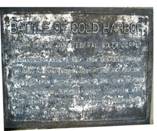 |
#25 Battle of Cold Harbor Position
of the Federal Sixth Corps
Advancing on June 1, 1864 from
Old Cold Harbor, the Federal Sixth
Corps
occupied this and adjacent positions from which on June 3 the
Army of the Potomac delivered repeated
assaults against the main Confederate
defences, which were approximately 400 yards
westward. |
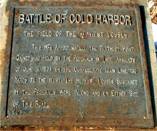 |
#26 Battle of Cold Harbor The
Field
of the Heaviest Losses
This was approximately the
farthest point gained and held by the Federals
in their assaults of June 3, 1864 on the
Confederate main line, 130
yards to the west.
The heaviest losses sustained by the Federals were
along and on either side of this road. |
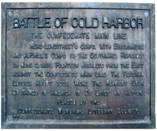 |
#27 Battle of Cold Harbor The
Confederate
Main Line
Here Longstreet’s Corps, with
Breckinridge and A.P. Hill’s Corps to
the
southward, repulsed on June 3, 1864, fourteen assaults from the
East against the confederate main line. The
federal losses, about
7000, were the heaviest
ever sustained in America in so brief an action.
Placed by the Confederate Memorial Literary
Society. |
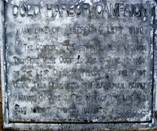 |
#28 Battle of Cold Harbor Main
Line
of Anderson’s Left Wing
The Confederate earthworks here
crossing this road were occupied May
31 – June
12, 1864, by the Left Division “Fields” of the First Corps.
Then commanded by R.H. Anderson. Heavily
attacked on June 3, this
part of the line was
held against repeated assaults. |
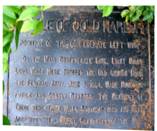 |
#29 Battle of Cold Harbor Position
of the Confederate Left Wing
On the main Confederate line,
eight miles long, which here crossed
the Old
Church Road, the Federal Army, June 3, 1864, made numerous
futile and costly charges. The heaviest of
these were three miles
southeastward and were
accounted “the worst slaughter of the war”. |
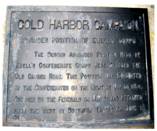 |
#30 Cold Harbor Campaign Advanced
Position of Ewell's Corps
The second advanced position held
by Ewell’s Confederate Corps here
crossed the
Old Church Road. This position was evacuated by the Confederates
on the night of May 30, 1864. Occupied by the
Federals on May 31 and
attacked from the West
by Southern troops on June 1. |
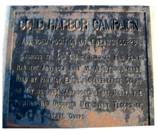 |
#31 Cold Harbor Campaign Advanced
Position of Ewell's Corps
Across the Old Church road at
this point ran the advanced line of
about 700
yards held by part of Ewell’s Confederate Corps on May 30,
1864. Abandoned that night, the position was
occupied May 31 by troops
of the Fifth Federal
corps. |
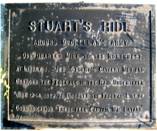 |
#32 Stuart’s Ride Around
McClellan’s
Army
One-quarter
mile to the Northwest, at Linney’s, “Jeb” Stuart’s cavalry
met and charged the Federals in the raid
undertaken June 12-14, 1862,
to discover the
Federal line of communication. There fell Captain
Wm. Latane’. |
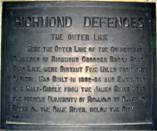 |
#33 Richmond Defences The Outer
Line
Here the
outer line of the Confederate defences of Richmond crossed
Brook Road. This line, here distant five miles
from the capitol, was
built in 1862-64 and
extended in a half-circle from the James River
near the present University of Richmond to
Chaffin’s Bluff on the
same river, below the
city. |
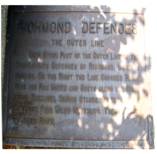 |
#34 Richmond Defences The Outer
Line
Here stood
part of the outer line of the Confederate defences of Richmond,
built in 1862-64. On the right the line
crossed Brook Road and ran
North and South
along the ridge where Emmanuel church stands. On the
left it extended four miles Westward, thence
South to James River. |
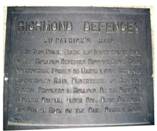 |
#35 Richmond Defences Kilpatrick’s
Raid
At this
point, where the intermediate line of the Richmond defences
crossed Brook Road, Confederate forces on
March 1, 1864, repulsed
Kilpatrick’s Raid,
undertaken to release Federal prisoners in Richmond.
On the same day, another column, under Col.
Ulric Dahlgren was driven
back on the Cary
Street Road. |
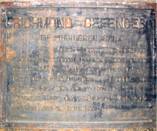 |
#36 Richmond Defences The Dahlgren
Raid
Here March
1, 1864, two regiments of Confederate local defence troops
under Col. John McAnerney defeated Federal
cavalry under Col. Ulric
Dahlgren, who sought
to destroy Richmond and to release Federal prisoners
there. On the same day Kilpatrick was repulsed
on Brook Road. |
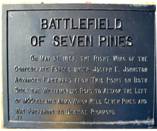 |
#37 Battlefield of Seven Pines
On May 31, 1862, the Right Wing
of the Confederate Forces under Joseph
E.
Johnston advanced Eastward from this point on both sides the
Williamsburg
Road to attack the left of
McClellan's Army which held Seven Pines
and
was preparing to besiege Richmond. |
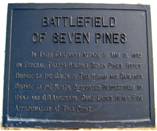 |
#38 Battlefield of Seven Pines
In their Eastward attack of May
31, 1862 on Federal troops holding
Seven
Pines, Rodes' Brigade to the South of this highway and Garland’s
Brigade to the North, supported respectively
by Rains and G.B. Anderson,
came under heavy
fire approximately at this point. |
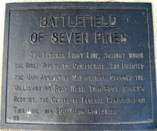 |
#39 Battlefield of Seven Pines
The Federal First Line, against
which the Right Wing of the Confederate
Army
directed the main assault of May 31, 1862, crossed the Williamsburg
Road near this spot. Casey's Redoubt, the
centre of Federal Resistance
on this line, was
200 yards Southward. |
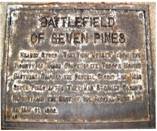 |
#40 Battlefield of Seven Pines
Nearby stood "The Twin Houses"
from the vicinity of which Confederate
Troops
moving eastward, charged the Federal Second Line near Seven
Pines after they had stormed Casey's Redoubt
and the rest of the Federal
First Line on May
31, 1862. |
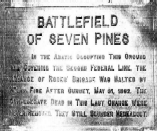 |
#41 Battlefield of Seven Pines
In the abatis occupying this
ground and covering the second Federal
line,
the advance of Rodes' Brigade was halted by heavy fire after
sunset, May 31,1862. The Confederate dead in
this last charge were
never removed. They
still slumber hereabout. [Courtesy of Michael Tyler] |
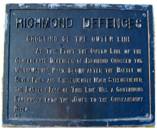 |
#42 Richmond Defences Crossing of
the Outer Line
At
this point the outer line of the Confederate Defences of Richmond
crossed the Williamsburg Road. Begun after the
Battle of Seven Pines
and subsequently much
strengthened, the Eastern face of this line
was a continuous earthwork from the James to
the Chickahominy River. |
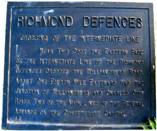 |
#43 Richmond Defences Crossing of
the Intermediate Line
Near this spot the Eastern face of
the Intermediate Line of the Richmond
Defences
crossed the Williamsburg Road. About one-fourth mile Eastward
was the Junction of Williamsburg and Charles
City Roads, two of the
main lines of the
Federal advance on the Confederate capital. |
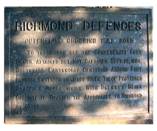 |
#44 Richmond Defences Outer-Line
Crossing Mill Road
To the North was the Confederate
Fort Gilmer, attacked but not captured,
Sept.
29,1864. Southward, earthworks centering around Fort Harrison
extended to James River. These protected
Chaffin's Bluff which, with
Drewry's Bluff
opposite it, guarded the approaches to Richmond by
water. |
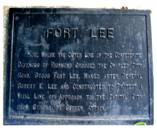 |
#45 Fort Lee
Here, where the outer line of the
Confederate defences of Richmond
crossed the
Charles City Road, stood Fort Lee, named after General
Robert E. Lee and constructed to protect a
vital line of approach
to the capital city
from strong or sudden attack. |
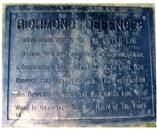 |
#46 Richmond Defences Advanced
Works
of the Outer Line
Running Southeastward and then
Southwestward. A Confederate earthwork,
three
miles long, here crossed the Darbytown Road. This fortification
was designed to cover the Main Outer Line,
with which it connected,
one mile North of
this point. |
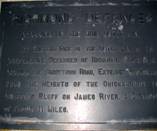 |
#47 Richmond Defences Crossing of
the Main Outer Line
The eastern face of the Outer Line
of the Confederate defences of
Richmond, which
here crossed the Darbytown Road, extended Southward
from the heights of the Chickahominy to
Chaffin's Bluff on James River,
a distance of
about 11 miles. |
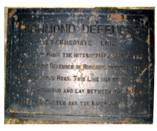 |
#48 Richmond Defences Intermediate
Line
At this
point the Intermediate Line of the Confederate defences of
Richmond crossed this, the Darbytown Road.
This line was continuous
around Richmond and
lay between the outer defensive system and the
inner forts. |
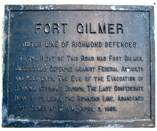 |
#49 Fort Gilmer Outer Line of
Richmond
Defences
To the
right of this road was Fort Gilmer, successfully defended against
Federal assaults and held until the eve of the
evacuation of Richmond.
Kershaw's Division,
the last Confederate infantry to leave the Richmond
line, abandoned Fort Gilmer at 3 A.M., April
3, 1865. |
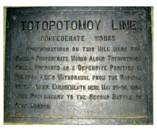 |
#50 Totopotomoy Line Confederate
Works
Fortifications
on this hill mark the strong confederate works along
Totopotomoy Creek, prepared as a defensive
position in General Lee’s
withdrawal from the
Rapidan to the James. Engagements here May 29-30,
1864, were preliminary to the Second Battle of
Cold Harbor. |
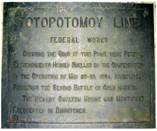 |
#51 Totopotomoy Line Federal
Works
Crossing the road at this point
were Federal entrenchments heavily
shelled by
the Confederates in the operation of May 29-30, 1864, immediately
preceding the Second Battle of Cold Harbor.
The nearby Shelton House
was mentioned
frequently in dispatches. |
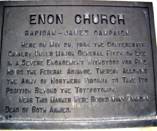 |
#52 Enon Church Rapidan-James
Campaign
Here on May 28, 1864 the
Confederate cavalry under Major General Fitzhugh
Lee in a severe engagement withstood for five
hours the Federal advance,
thereby allowing
the Army of Northern Virginia to take its position
beyond the Totopotomoy. Near this marker were
buried many unknown
dead of both armies. |
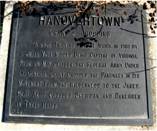 |
#53 Hanovertown Grant's
Crossing
A once thriving village which
in 1761 by a small vote missed being
capital
of Virginia. Here on May 27, 1864 the Federal army under Lt.
General Grant crossed the Pamunkey in its
movement from the Wilderness
to the James.
Here also crossed Sheridan and Dahlgren in their raids. |
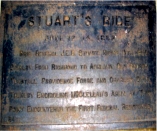 |
#54 Stuart's Ride June 13-14,
1862
Brig. General J.E.B. Stuart,
riding with 1800 cavalry from Richmond
to
Ashland, Old Church, Tunstall, Providence Forge, and Charles City,
thereby encircling McClellan's Army, at this
point encountered the
first Federal
resistance. [Courtesy of Michael Tyler] |
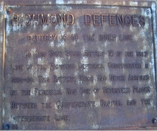 |
#55 Inner Defences Battery 16 of
the Inner Line
On
this spot stood Battery 16 of the Inner Line of the Richmond
Defences,
constructed in 1862-64. This
Battery, which was never assailed by
the
Federals, was one seventeen placed between the Confederate capital
and the Intermediate Line. |
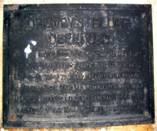 |
#56 Drewry’s Bluff Defences
Here, on the second line of
the Drewry’s Bluff defences, Confederate
troops were concentrated May 12-15, 1864, to
take the offensive against
a Federal force
that had advanced from Bermuda Hundred under command
of General B.F. Butler and had cut the
Richmond–Petersburg railroad. |
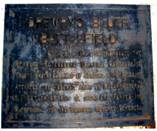 |
#57 Drewry’s Bluff Battlefield
On a line that here crossed
the Richmond–Petersburg turnpike, Confederate
troops under command of General G.T.
Beauregard attacked the Federal
army of
Major-General B.F. Butler on May 16, 1864 and forced its withdrawal
to the Bermuda Hundred defences. |
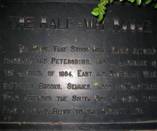 |
#58 The Half-Way House
The house that stood here, midway
between Richmond and Petersburg,
was a
landmark in the campaign of 1864. East and Southeast were Batteries
Brooks, Semmes, Wood and Dantzler which
defended the South side of
James river from
Drewry’s Bluff to the Howlett Line. |
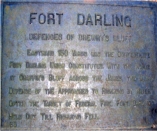 |
#59 Fort Darling Defences of
Drewry's
Bluff
Eastward
150 yards was the Confederate Fort Darling which constituted,
with the works at Chaffin’s Bluff across the
James, the main defence
of the approaches to
Richmond by water. Often the target of Federal
fire, Fort Darling held out till Richmond
fell. |
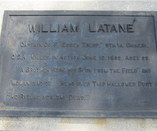 |
#60 William Latané
Captain Co. F, "Essex Troop," 9th Va. Cavalry, C.S.A., killed in action June 13, 1862, aged 29. "A brother bore his body from the field" and "woman's voice.....read over this hallowed dust the ritual for the dead." |

